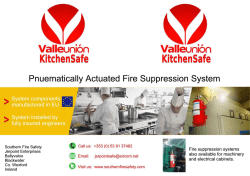
415 Simulation of Hydrogen Deflagration Experiment – Benchmark
Simulation of Hydrogen Deflagration Experiment – Benchmark Exercise with Lumped-Parameter Codes Ivo Kljenak Jožef Stefan Institute Jamova cesta 39 1000 Ljubljana, Slovenia ivo.kljenak@ijs.si Mikhail Kuznetsov Karlsruhe Institute of Technology Kaiserstraße 12 76131 Karlsruhe, Germany mike.kuznetsov@kit.edu Pal Kostka NUBIKI Nuclear Safety Research Institute Konkoly-Thege Miklós út 29-33 1121 Budapest, Hungary kostka@nubiki.hu Lubica Kubišova Nuclear Regulatory Authority of the Slovak Republic Bajkalská 27 82007 Bratislava, Slovakia lubica.kubisova@ujd.gov.sk Giovanni Manzini Ricerca sul Sistema Energetico Via Rubattino 54 20134 Milano, Italy giovanni.manzini@rse-web.it Mantas Povilaitis Lithuania Energy Institute Breslaujos g.3 44403 Kaunas, Lithuania mantas.p@mail.lei.lt ABSTRACT An experiment on hydrogen deflagration (Upward Flame Propagation Experiment – UFPE) was performed in the HYKA A2 facility at the Karlsruhe Institute of Technology (Germany). The experimental results were used to organise a benchmark exercise for lumpedparameter codes. The results of the experiment and simulations are presented and discussed. 1 INTRODUCTION The issue of hydrogen combustion during a severe accident in a nuclear power plant (NPP) came to prominence after the accident at the Three Mile Island (USA) NPP in 1979, and has received new attention since the accident at the Fukushima Daiichi (Japan) NPP in 2011. In 2012, the Upward Flame Propagation Experiment (UFPE) on hydrogen combustion, which was proposed by the Jožef Stefan Institute (JSI) in 2010, was carried out at the Karlsruhe Institute of Technology (KIT) in Germany. The experiment was performed in the HYKA A2 facility, which is basically a cylindrical vessel with a volume of about 200 m3. A homogeneous hydrogen-steam-air mixture was ignited near the bottom of the vessel, and the ensuing flame propagation was observed. For safety analyses of nuclear power plants, hydrogen deflagration in a containment should be adequately simulated. Although models of hydrogen deflagration, implemented in lumped-parameter codes (which model the reactor containment as a network of control volumes, in which the conditions are in principle modelled as homogeneous) do not reflect all the complexity of the combustion process, such codes are still likely to be used. Namely, the 415.1 415.2 containment of actual NPPs are much too large for combustion to be simulated using socalled Computational Fluid Dynamics (CFD) codes, which solve the basic transport equations of fluid mechanics and additional constitutive equations on the local instantaneous scale. Within the Severe Accident Research Network (SARNET, 7th EC Framework Programme), a benchmark exercise was organised by JSI, with the purpose to compare simulation results of the UFPE experiment, obtained either with different lumped-parameter codes or with same lumped-parameter codes but different input models. Apart from the organizer, the following organisations also took part in the benchmark: Lithuania Energy Institute - LEI (Lithuania), NUBIKI Nuclear Safety Research Institute (Hungary), Ricerca sul Sistema Energetico - RSE (Italy) and Nuclear Regulatory Authority of the Slovak Republic - UJD SR (Slovakia). In the present paper, the results obtained with different codes (pressure and temperature increase, flame axial and radial propagation) are compared to the experimental results, with the main purpose of assessing the general possibilities of lumped-parameter modelling. 2 EXPERIMENT 2.1 Experimental Facility The volume of the HYKA A2 test facility, as prepared for the UFPE experiment, is 201_m3. The inner height is 9.0 m, whereas the inner diameter is 6.0 m. A photograph of the facility with its external thermal isolation is shown in Figure 1, whereas Figure 2 shows a schematic in which the shape of the vessel interior may be seen. A floor made of planks was installed 1 m above the vessel bottom to isolate the part in which hydrogen combustion occurred from the sump region. In the present paper, that floor is defined as level 0 m. The ignition device was located at the vessel axis, approximately 1.25 m from that level. Figure 1. Photograph of HYKA A2 experimental facility (KIT). Figure 2. Schematic of HYKA A2 vessel. 415.3 2.2 Experimental Conditions The UFPE experiment was performed at the following initial conditions: pressure 1.49_bar, temperature 90 °C, steam concentration 20 vol.%, and hydrogen concentration 12 vol.% (the remaining atmosphere component being air). The atmosphere composition was homogeneous, which was ensured by mixing using fans. The fans were switched off and the turbulence was allowed to decay before the execution of the experiment. The mixture was ignited at the bottom of the facility (Figure 2). 3 PARTICIPANTS, LUMPED-PARAMETER CODES AND INPUT MODELS The participating organisations and codes are listed in Table 1. Performed calculations were “blind” (that is, without prior knowledge of experimental results) or “open” (after experimental results have been disclosed). Further open calculations by organisations that have performed only blind calculations so far are planned. Table 1: Participating organisations, codes, performed calculations. Organisation JSI UJD SR RSE NUBIKI LEI 3.1 Code ASTEC COCOSYS ECART ASTEC ASTEC Calculation Open Blind & Open Blind & Open Blind Blind Hydrogen Combustion Modelling To simulate hydrogen combustion and flame propagation, lumped-parameter codes use algebraic models. The ASTEC and the COCOSYS code are based on similar principles. A_flame front model calculates the flame propagation from one control volume into adjacent ones. The flame propagation takes place within the junction of the system (flow connections between the volumes). The combustion of the gas mixture takes place in the volumes and is calculated by a combustion model. In addition to the simplified combustion model, a_checking is performed, whether the gas mixture in a volume is ignitable or not (that is, whether ignition criteria are fulfilled according to the ternary Shapiro diagram). The boundary conditions for possible flame propagations and its directions are checked as well based on the ternary diagram. Combustion stops after combustion completeness criteria are reached. The ECART H2Ex model is dedicated to air – hydrogen mixture fast deflagrations and it is internally divided into two sub-models relating, respectively, to the outdoor (open spaces) and indoor (confined spaces) explosions. With regard to explosion in confined environment, a_sub-model based on results of FP5 SAFEKINEX research project was created. Both submodels consist of a set of correlations that provide the values of temperature and pressure required for a calculation in the first approximation of the effects of explosion. 415.4 3.2 Input Models For the ASTEC code, nodalisations of input models are shown in Figure 3 (JSI, 95 control volumes – c.v.), Figure 4 (LEI, 27 c.v.) and Figure 5 (NUBIKI, 45 c.v.). For the COCOSYS code (UJD SR, 35 c.v. for the blind calculation and 21 c.v. for the open calculation), the nodalisation is shown in Figure 6. Finally, the input model of the ECART code consisted only of a single control volume. Although this precludes the simulation of flame propagation, the results of calculated pressure and temperature are still valuable. Figure 3. JSI input model (ASTEC code) Figure 4. LEI input model (ASTEC code) Figure 5. NUBIKI input model (ASTEC code) Figure 6. UJD SR input model (open calculations, COCOSYS code) 415.5 4 EXPERIMENTAL AND SIMULATION RESULTS 4.1 Pressure Figure 7 shows the experimental and calculated pressures (both are more or less uniform over the entire vessel). In terms of nuclear safety, the most important aspects are the value of the maximum pressure and the pressure increase rate. The disagreement of all calculated results with these two experimental variables is acceptable. For results obtained by RSE and UJD SR, it is interesting to observe the improvement of agreement between the blind and open calculations. 4.2 Temperature Within the benchmark exercise, the calculated temperatures at 8 locations were compared with experimental results. In the present paper, comparisons are presented for two locations, both at elevation 3 m above the floor: at the vessel axis (Figure 8) and 0.3 m from the vessel wall (Figure 9). The main discrepancy may be noticed in Figure 8, where the temperature calculated by JSI is much too high, contrary to the results of LEI and NUBIKI, obtained with the same code. A possible reason may be the higher number of control volumes on the radial direction in the JSI model. Near the vessel wall, this discrepancy of JSI results did not occur. Something similar may be observed in the RSE results, but only in the blind calculations. 5 6x10 Experiment LEI (Blind) NUBIKI (Blind) UJD SR (Blind) UJD SR (Open) RSE (Blind) RSE (Open) JSI (Open) 5 Pressure (Pa) 5x10 5 4x10 5 3x10 5 2x10 0 10 20 30 Time (s) Figure 7. Experimental and calculated pressures. 40 415.6 1800 EXPERIMENT LEI (Blind) NUBIKI (Blind) UJD SR (Blind) UJD SR (Open) RSE (Blind) RSE (Open) JSI (Open) Temperature [ K] 1500 1200 900 600 z = 3.0 m r = 0.0 m 300 0 5 10 15 20 25 Time [s] 30 35 40 Figure 8. Experimental and calculated temperatures at vessel axis, elevation 3.0 m. Temperature [ K] 1800 EXPERIMENT LEI (Blind) NUBIKI (Blind) UJD SR (Blind) UJD SR (Open) RSE (Blind) RSE (Open) JSI (Open) 1500 1200 900 600 z = 3.0 m r = 2.7 m 300 0 5 10 15 20 25 Time [s] 30 35 40 Figure 9. Experimental and calculated temperatures near vessel wall, elevation 3.0 m. 415.7 4.3 Axial and Radial Flame Propagation In terms of nuclear safety, the accurate prediction of axial and radial flame propagation are of lesser importance. Accurate predictions are more considered as indications of the correctness and soundness of the modelling of hydrogen combustion. Figure 10 shows the experimental and calculated axial flame propagation, whereas Figure 11 shows the same for radial flame propagation, at elevation 1.5 m. The calculated results of flame axial propagation show that the COCOSYS code apparently predicts the flame velocity better than the ASTEC code. For the radial flame propagation, the dispertion of results is somewhat higher. Still, the discrepancies are acceptable. The observation of the radial flame propagation was one of the main benefits of the UFPE experiment. Namely, due to the smaller diameter of vessels in which earlier experiments were performed, this could not be observed. Thus, this experiment is an excellent opportunity to assess the simulation of radial flame propagation with lumped-parameter codes. Of course, as the vessel radius was subdivided only into a few control volumes, the resolution of the simulation results is very low. Nevertheless, as radial flame propagation might be expected during hydrogen combustion in an actual containment, the simulations are still valuable. 5 CONCLUSIONS The calculated results have shown that, despite a few relatively large discrepancies, the lumped-parameter codes used in the benchmark exercise may be used for safety analyses of actual plants. However, it should be noted that no participant obtained completely satisfactory agreement with experimental results for all calculated variables. The main issues that remain open are the following: — Development of adequate physical models that will provide accurate results despite the simplifications inherent in lumped-parameter codes. — Necessity of nodalisation guidelines for development of geometrical input models which will be in accordance with physical models. ACKNOWLEDGMENTS The Jožef Stefan Institute and the Karlsruhe Institute of Technology wish to acknowledge the financing of the preparation and execution of the experiment by the European Commission within the LACOMECO project (2010-2012). The work of the Jožef Stefan Institute was financed by the Slovenian Research Agency (project J2-4265). REFERENCES [1] I.Kljenak, A.Bentaib, T.Jordan, Hydrogen Behavior and Control in Severe Accidents, in: Nuclear Safety in Light Water Reactors, B.R.Sehgal ed., pp. 186-227, Elsevier 2012. [2] I.Kljenak, M.Kuznetsov, G.Stern, M.Matkovič, B.Mavko, Upward Flame Propagation Experiment on Hydrogen Combustion, Technical Report IJS-DP-11231, Jožef Stefan Institute, Ljubljana, Slovenia, February 2013. 415.8 9 Flame axial position 8 Elevation (m) 7 6 5 4 EXPERIMENT LEI (Blind) NUBIKI (Blind) UJD SR (Blind) UJD SR (Open) JSI (Open) 3 2 1 0 1 2 3 Time (s) 4 5 6 Figure 10. Experimental and calculated axial flame propagation. 3.0 2.5 Radius (m) 2.0 1.5 Flame radial position 1.0 EXPERIMENT LEI (Blind) NUBIKI (Blind) UJD SR (Blind) UJD SR (Open) JSI (Open) 0.5 0.0 0 1 2 3 Time (s) 4 5 6 Figure 11. Experimental and calculated radial flame propagation.
© Copyright 2025









